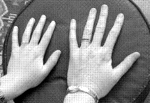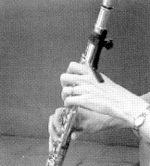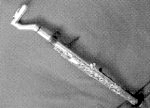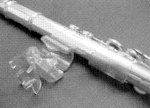|
Return to Alexa Still main page
|
|
CUSTOMISED FLUTES
A native of New Zealand, Alexa studied in the US with Samuel Baron and Thomas Nyfenger. She became principal flute of the New Zealand Symphony Orchestra at the age of 23, and returned home for 11 years. Since being appointed Asociate Professor of Flute at the University of Colorado at Boulder (1998) she has presented recitals, concertos and masterclasses all over the world. Her 12th solo compact disc on the Koch International Classics label (chamber music for flute by Lowell Liebermann) is scheduled for release in July and another concerto disc later in the autumn. She is currently swamped by duties as programme chair for the 2003 NFA convention.
ALTHOUGH FLUTES COME IN STANDARD SIZES, IT IS CLEAR THAT FLAUTISTS DO NOT! FEW OF US ARE LUCKY ENOUGH TO HAVE THE PRIVILEGE OF A HANDMADE FLUTE AT OUR DISPOSAL, SO WHAT CAN WE DO TO MAKE PLAYING MORE COMFORTABLE? ALEXA STILL LOOKS AT SOME OF THE WAYS IN WHICH YOU CAN TAILOR YOUR FLUTE TO YOUR OWN PERSONAL NEEDS. In recent years there has been a growing awareness of things both ergonomic and not-so-ergonomic. There have been some radical changes in musical instrument designs reflecting this (for example, the violas built by Otto Erdesz). For those flautists who understand what will suit them individually, most makers of handmade flutes willingly and expertly accommodate special requests in key designs to suit individual hands. This article is intended to inform those who are experiencing some discomfort or whose students are struggling, and/or those who are just plain curious. You can try all the items discussed in this article on your flute without permanent alteration to the instrument or major financial investment. These items are available ready to apply to your flute, or are do-it-yourself creations using components readily available from local shops.
Ready-made extensions/add-ons
(This sounds scary, but it comes off very easily if required.) This G# extension key has a clever sprung lever offering a choice of positions and actually folds in towards the flute body for stowing away in your case. As these were designed for the flutes made by Brannen Brothers, those who play Brannen flutes can buy the extensions individually. Those who play other open hole flutes can also use these wonderful keys: the plug parts of keys are cut to order, to fit into different sized open holes. Because this must be done to order, the extensions are available for non-Brannen flutes in full sets. All unwanted keys may be returned for a refund.
The do-it-yourself Variety Pauline Mancuso, a wonderful flautist and one of my Flute List buddies, has firsthand experience of injuries and has subsequently invested a lot of time experimenting. Her extremely helpful articles can be found, along with other fascinating material, under the performance health section on Larry Krantz's website (www.LarryKrantz.com). Pauline is a fan of the DIY approach: 'As long as we are experimenting with comfort and position, we might as well do it with handy, inexpensive materials until we get the alignment we want. Next week, we may change our minds anyway.' The easiest DIY adaptation is to change the height of the key by raising its surface. Pauline suggests two ways of doing this for the G# key: purchasing a saxophone palm key riser (built to fit on a similar lever-type key, but may wobble); or (cheaper) gluing on a piece of cork (available from hardware and craft stores, or maybe from your next bottle of wine). Cork is best cut with exceptionally sharp blades, so please be careful. Sanding with an emery board or nail file is reasonably easy. For other keys, such as the G key (bdth inline and offset), Pauline points out that we do not have to place the finger in the middle of the key. She suggests gluing on a 'pearl' sax key button at the point where it is comfortable to touch the key this is a much nicer surface than an edge. If your flute is also open-hole, you can use a silicon plug to plug it up. As an alternative to the plug, another of my Flute List buddies (please forgive me for forgetting exactly who) suggested covering the hole with electrical tape, to avoid changing the acoustic dimensions of an open-hole flute. Glues (for applying gadgets to metal keys or metal tubing only!) Look for glue that either peels off or has an easy-to-use solvent (buy this at the same time). I like contact cements and silicon glues, but not those designed for permanent fixtures. The sulphur content in rubber bands will mark silver, but I have never had a discolouration from using rubber contact cement. My understanding is that rubber contact cement seals the silver from contact with oxygen, preventing the reaction from happening. To be sure, try a little dab of the glue you are thinking of using on the back of a piece of silverware before using the glue on your flute. Another good way of affixing things is to use sticky-backed Velcro (available in a craft or sewing supplies store) or double-sided sticky tape, which also requires a solvent to remove completely.
With the wider tubing that results from the added hose, you may find the placement of the fingers on the keys changes, especially for the left-hand index finger. In this case, you may want to try an extension key or Pauline's idea of gluing on the pearl sax button, as for the G key. Flautists sometimes just like the tactile sense of something other than the smooth metal tubing, keys or lip plate, and don't necessarily need a lot of extra width or padding. I remember feeling, as a very sweaty teenager, that pieces of postage stamps (the sort you have to lick) in strategic places made the difference between me dropping the flute or not! Sanford Drelinger often gives away sets of the same selfadhesive foam that is on the face of his left-hand index extension key. This works well, particularly for the contact areas on the tubing. Moleskin (another of the foot products) is also popular, and so are self-adhesive rings for lining the perforated holes on paper for ring binders. Some flautists find that the damping effect and/or extra weight of add-ons or extensions can make the flute's sound seem less vibrant. Pauline advocates the use of a stopper made by Robert Bigio to increase or restore the responsiveness of the flute (a picture of one of these is included in the photo with the com pads). Many people seek out these very popular stopper and crown assemblies anyway, because of the resulting increase in volume that will occur in many flutes! Alternatively, different (lighter) weight crowns, or even no crown at all, may brighten the sound sufficiently. I hope that this information will give you some food for thought, and I would welcome hearing about any other additions you or a friend may have designed! |
|
Return to Alexa Still main page
|







